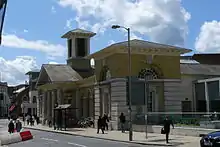Owen Browne Carter
Owen Browne Carter (1806 – 30 March 1859) was an English architect, based in Winchester, but also had works commissioned from all around the country. He designed several public buildings, such as The Corn Exchange in Winchester, now the Library. In addition to this, he designed several townhouses and estates, such as Nork House in Nork Park in Banstead, Surrey.

Life
Carter was born in London in 1806. He spent 10 years employed in the office of the architect William Garbett (1770–1834) in Winchester,[1] where he was to spend most of his life.[2] Following Garbett's death, Carter oversaw the construction of St John's South, a group of almshouses, to his late employer's design.[3]
In about 1829–30 he went to Egypt in the company of Robert Hay. He spent some time in Cairo, where he made a large number of architectural and topographical drawings,[2] about fifty of which are in collection of the British Museum.[1] Some of these drawings were lithographed under Carter's supervision, and published by Hay in 1840 in a folio volume entitled Illustrations of Cairo.[2]
In 1836, shortly after his travels to Egypt, he began work on the restorations, extensions and additions of Nork House, in Banstead, Surrey. The works were commissioned by the Right Honorable Lord Arden, who had purchased the house and large extensive estate a few years before. The house was built in 1614, but had been remodeled and re designed to suit previous owners.[4] The works by Carter were the largest the house had seen, and ensured the mansion house stood the biggest grandest house there was for many years to come, but was demolished shortly after the Second World War. Drawings of the house and plans by Carter are currently held by Metropolitan Museum of Arts, in New York, America.
Afterwards, he drew up designs for the new church of St Peter, Southampton, and for the rebuilding of St Matthew, Otterbourne (in collaboration with the squire, William Yonge,[5] replacing an older church about half-a-mile away),[6] St Mary, Nutley, and St. Michael and All Angels, Knights Enham, although the last of these was not carried out.[5] Carter was also responsible for restorations or alterations at St. Peter ad Vincula, Colemore; St. Leonard, Grately and St Leonard, Oakley, all in Hampshire.[5]
His buildings in Winchester included the New Corn Exchange (now a public library),[7] with a central portico modelled on that of Inigo Jones' St Paul, Covent Garden.[1] Describing the front of the building, The Gentleman's Magazine said that Carter had "endeavored to avoid the flimsy effect of the modern Grecian school, and to keep in view the more legitimate style of design inculcated by Palladio in Italy, and at home by our own countrymen, Jones and Wren."[8] In 1845 he restored the Great Hall of the Royal Palace at Winchester, renewing the stonework of the parapet and gables, and the plate tracery in the windows, removing the late 18th-century wooden window frames, and replacing the Georgian brick porch with one of a Gothic design. [7]
He exhibited architectural drawings at the Royal Academy between 1847 and 1851, showing designs for the rebuilding of Holyrood church, Southampton, and for restorations of the Poultry Cross at Salisbury (carried out in 1852-4)[9] and the screen at Winchester Cathedral. His address is given in the catalogues as 22 Southgate Street, Winchester.[10] He published some works on local subjects such as Picturesque Memorials of Winchester (1830), and contributed articles to John Weale's Quarterly Papers on Architecture on the stained-glass windows of Winchester Cathedral, on Beaulieu Abbey, and on the churches of Penton Mewsey, Headbourne Worthy, and Bishopstone. All these articles were illustrated with his own drawings.[2]
George Edmund Street, a relative, received his initial architectural training with Carter in 1841–44.[11]
Death
Carter died at Salisbury on 30 March 1859, aged 53.[2]
References
- "Winchester Library - The history of the building". Oxford Archaeology. Retrieved 15 October 2013.
- Cust 1887, p. 205
- "Photograph of the Broadway, Winchester including St John's South". Winchester Museums. Retrieved 21 November 2013.
- "Banstead History Research Group (BHRG) - Home Page". www.bansteadhistory.com. Retrieved 28 December 2020.
- "ICBS files where Professional's Name equals 'CARTER, Owen Browne: b. 1806 - d. 1859 of Winchester". Church Plans online. Retrieved 14 October 2014.
- "St Matthew's Church, Otterbourne". Hantsphere. Retrieved 14 October 2014.
- Biddle, Martin; Badham, Sally (2000). King Arthur's Round Table: an archaeological investigation (1. publ. ed.). Woodbridge, Suffolk [u.a.]: Boydell Press. ISBN 9780851156262.
- "Domestic Occurrences". The Gentleman's Magazine: 316.
- "Major Secular Buildings". Ancient and Historical Monuments in the City of Salisbury. Institute of Historical Research. 1977. Retrieved 1 December 2013.
- Graves, Algernon (1905). The Royal Academy: A Complete Dictionary of Contributors from its Foundations in 1769 to 1904. 2. London: Henry Graves. p. 6.
- Street, Arthur Edmund (1888). Memoir of George Edmund Street, R.A., 1824-1881. London: John Murray. pp. 4–6. Carter was a cousin of a painter and art teacher called Haseler, Street's uncle by marriage.
Sources
